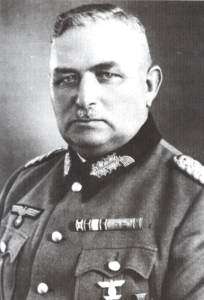Adolf Hamann
| Adolf Hamann | |
|---|---|
 General Adolf Hamann. | |
| Born |
3 September 1885 Groß Laasch, Mecklenburg-Schwerin, German Empire |
| Died |
30 December 1945 (aged 60) Bryansk, Soviet Union |
| Buried at | German prisoner-of-war cemetery, Bryansk |
| Allegiance |
|
| Service/branch | Heer |
| Years of service | 1901–44 |
| Rank | Generalleutnant |
| Battles/wars |
World War I World War II |
Adolf Hamann (3 September 1885 – 30 December 1945) was a German general.
Life and the military
Early life
Hamann joined the Schwerin 89th Grenadier Regiment on 16 July 1901. He was promoted to corporal on 27 January 1904 and to Unteroffizier on 27 January the following year. Hamann became a Sergeant on 3 March 1908, and a Feldwebel on 1 October 1911. In 1914, during the first year of World War I, he was twice awarded the Iron Cross. On 7 August 1916, he was promoted to a Warrant Officer and appointed as a platoon commander.[1]
Interwar years
On 7 August 1919, Hamann was commissioned as a second Lieutenant and transferred to the 17th Infantry Regiment of the newly created Reichswehr, where he served as the commander's adjutant. On 1 October 1920, he was assigned to the 6th Infantry Regiment as a company's operations officer. On 15 January 1921 he was promoted to Lieutenant, and on 1 April 1923 he was given the rank of a Captain and the command over a company.[2]
On 1 July 1933, he was promoted to Major and assigned to staff duty. From 1 July to 1 October 1934, he commanded the Flensburg Infantry Battalion. Afterwards, he headed the 3rd Battalion of the Neumünster Regiment, and was transferred to the 46th Regiment on 15 October 1935, in which he commanded the 3rd Battalion, as well. On 1 March 1936 he was promoted to Lieutenant Colonel. From 1 February 1937 until 3 January 1939, he commanded the Stablak training area in East Prussia. While holding that office, he was promoted to Colonel on 1 August 1938. From January to 1 September 1939, he oversaw the Tiborlager training area near Schwiebus.[1]
World War II
Immediately after the German invasion of Poland, Hamann was given the command of a frontier defense zone on the Polish border, which he held until 8 January 1940. Afterwards, he commanded the 3rd Reserve Infantry Battalion until 25 July 1941. From 4 August until 14 January the following year, he headed the 239th Infantry Division's 327th Regiment. After the division was dissolved, he was transferred to the Führerreserve, where he remained until 1 April. Then he was posted as the commander of the 370th Division's 666th Regiment, stationed at Reims, in the French Zone occupée. He held the office for only six weeks and was recalled to the reserve on 14 May.[3]
On 1 June 1942, he was promoted to Major General and sent to serve as the governor of Oryol, in the German-occupied area of the Soviet Union. During the Battle of Kursk, while still commandant of Oryol, he was the chief of Gruppe Hamann - a support formation which consisted mainly of the 3rd Brandendburg Regiment and existed from 20 July to 1 August as part of General Lothar Rendulic's XXXV Corps. On 4 August, after Oryol's liberation in Operation Kutuzov, he was made commandant of Bryansk. When it was retaken by the Red Army on 17 September, he became the governor of Bobruisk, in Belorussia.[4]
On 1 June 1944, an order to promote Hamann to Lieutenant General was issued, though it was not implemented. At 20 June, he was given command of the 383rd Infantry Division, replacing General Edmund Hoffmeister, while retaining his position as commandant of what was now the Fortified Area Bobruisk.[5]
Capture and trial
On 22 June 1944, the Soviets launched Operation Bagration. The Red Army soon overwhelmed the German forces stationed near Bobruisk, and encircled the city on the 27th. On 28 June 1944, Hamann - along with the rest of the Bobruisk garrison - was taken prisoner.[5] On 17 July, he was paraded through the streets of Moscow with 50,000 other captured German soldiers.[6] He was officially promoted to Lieutenant General while in Soviet captivity, on 20 August 1944.[1]
On 30 December 1945, a Soviet court convicted him of war crimes[7] against the civilian populations of Bryansk [8] and Bobruisk.[9] Hamann was sentenced to death, and hanged on the same day.[1][5]
Awards and decorations
- Iron Cross of 1914, 1st and 2nd class
- Honour Cross of the World War 1914/1918
- Wound Badge in silver
- Clasp to the Iron Cross
- Wehrmacht Long Service Award
- Military Merit Cross, 1st and 2nd class (Mecklenburg-Schwerin)
References
- 1 2 3 4 A detailed biography of Adolf Hamann, on a website dedicated to the Generals and Admirals of the Wehrmacht.
- ↑ Hans Jürgen von Arnim (editor). Deutsches Soldatenjahrbuch 1982. Schild Verlag, 1982. ISBN 978-3-88014-076-9. Page 228.
- ↑ Samuel W. Mitcham Jr. The German Defeat in the East, 1944-45, ISBN 978-0-8117-3371-7. Page 87.
- ↑ Steven H. Newton , Kursk: The German View. ISBN 978-0-306-81150-0. Page 138.
- 1 2 3 Samuel W. Mitcham Jr. German Order of Battle, Volume Two: 291st 999th Infantry Divisions, Named Infantry Divisions, and Special Divisions in WWII. ISBN 978-0-8117-3437-0. Page 85.
- ↑ March of the Defeated.
- ↑ Gerd R. Überschär, Rainer Achim Blasius .Der Nationalsozialismus vor Gericht: Die alliierten Prozesse gegen Kriegsverbrecher und Soldaten 1943-1952. ISBN 978-3-596-13589-9. Page 257.
- ↑ The Gate to Hell: Bryansk Version, on the Bryansk Municipal Council's website.
- ↑ Full transcript of the USSR state report Crimes of the Fascist German Invaders in Belorussia, 1941-1945. Archived February 2, 2012, at the Wayback Machine.